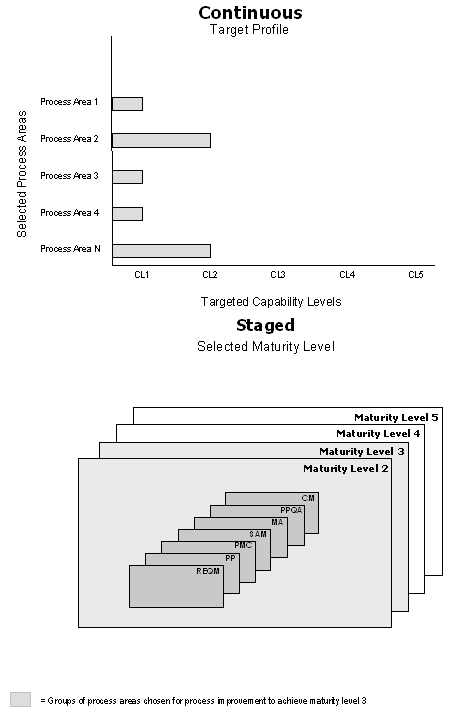Process areas are viewed differently in the two representations. Figure 3.2 compares views of how process areas are used in the continuous representation and the staged representation.

Figure 3.2: Process Areas in Continuous and Staged Representations
The continuous representation enables the organization to choose the focus of its process improvement efforts by choosing those process areas, or sets of interrelated process areas, that best benefit the organization and its
business objectives. Although there are some limits on what an organization can choose because of the dependencies among process areas, the organization has considerable freedom in its selection.
To support those using the continuous representation, process areas are organized into four categories: Process Management, Project Management, Engineering, and Support. These categories emphasize the relationships that exist among
the process areas and are discussed in Chapter 4.
Once you select the process areas, you must also select how much you would like to mature the processes associated with those process areas (i.e., select the appropriate capability level). Capability levels and generic goals and
practices support the improvement of processes associated with individual process areas. For example, an organization may wish to strive to reach capability level 2 in one process area and capability level 4 in another. As the organization reaches a
capability level, it sets its sights on the next capability level for one of these same process areas or decides to widen its view and address a larger number of process areas.
This selection is typically described through a target profile. A target profile defines all of the process areas to be addressed and the targeted capability level for each. This profile then governs which goals and practices the
organization will address in its process improvement efforts.
Most organizations will, at minimum, target capability level 1, which requires that all specific goals of the process area be achieved. However, organizations that target capability levels higher than 1 will concentrate on the
institutionalization of the selected processes in the organization by implementing the associated generic goals and practices.
Conversely, you will see that the staged representation encourages you to always look at process areas in the context of the maturity level to which they belong. The process areas are organized by maturity levels to reinforce this
concept.
The staged representation provides a predetermined path of improvement from maturity level 1 to maturity level 5 that involves achieving the goals of the process areas at each maturity level. To support those using the staged
representation, process areas are grouped by maturity level, indicating which process areas to implement to achieve each maturity level. For example, at maturity level 2, there is a set of process areas that an organization would use to guide its
process improvement until it could achieve all the goals of all these process areas. Once maturity level 2 is achieved this way, the organization focuses its efforts on maturity level 3 process areas, and so on. The generic goals that apply to each
process area are also predetermined. Generic goal 2 applies to maturity level 2 and generic goal 3 applies to maturity levels 3 through 5.
Table 3.2 provides a list of all process areas and their associated categories and maturity levels. To explain how the components of the process areas are viewed in each representation, we must discuss how the representations
address specific practices.
Table 3.2 Process Areas and Their Associated Categories and Maturity Levels
|
Process Area
|
Category
|
Maturity Level
|
|
Causal Analysis and Resolution
|
Support
|
5
|
|
Configuration Management
|
Support
|
2
|
|
Decision Analysis and Resolution
|
Support
|
3
|
|
Integrated Project Management +IPPD
|
Project Management
|
3
|
|
Measurement and Analysis
|
Support
|
2
|
|
Organizational Innovation and Deployment
|
Process Management
|
5
|
|
Organizational Process Definition +IPPD
|
Process Management
|
3
|
|
Organizational Process Focus
|
Process Management
|
3
|
|
Organizational Process Performance
|
Process Management
|
4
|
|
Organizational Training
|
Process Management
|
3
|
|
Product Integration
|
Engineering
|
3
|
|
Project Monitoring and Control
|
Project Management
|
2
|
|
Project Planning
|
Project Management
|
2
|
|
Process and Product Quality Assurance
|
Support
|
2
|
|
Quantitative Project Management
|
Project Management
|
4
|
|
Requirements Development
|
Engineering
|
3
|
|
Requirements Management
|
Engineering
|
2
|
|
Risk Management
|
Project Management
|
3
|
|
Supplier Agreement Management
|
Project Management
|
2
|
|
Technical Solution
|
Engineering
|
3
|
|
Validation
|
Engineering
|
3
|
|
Verification
|
Engineering
|
3
|